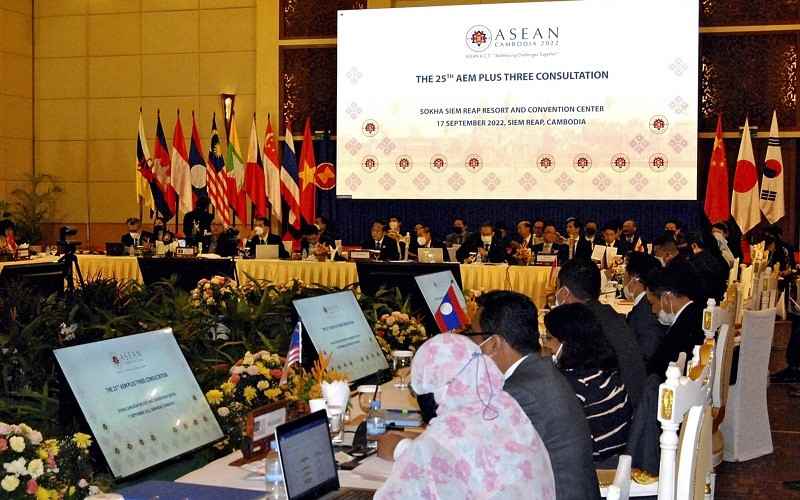Japan, U.S. aim for stronger economic cooperation with ASEAN nations

Economic ministers and others from Japan, China and member countries of the Association of Southeast Asian Nations attend a meeting in Siem Reap, Cambodia, on Saturday.
6:00 JST, September 21, 2022
SIEM REAP, Cambodia — Japan and the United States are trying to accelerate economic cooperation with Southeast Asian countries. Home to many manufacturing plants, Southeast Asia is central to the global supply chain and an important region in terms of economic security.
The two nations aim to counter China, which has increased its economic clout through the building of infrastructure in the region.
More cooperative ties
On Saturday, a meeting of economic ministers and others from Japan, the United States, China, Russia and member nations of the Association of Southeast Asian Nations was held in Siem Reap, northwestern Cambodia.
Economy, Trade and Industry Minister Yasutoshi Nishimura, who represented Japan, told reporters: “Next year marks 50 years of friendship and cooperation between Japan and the ASEAN. Japan will take this opportunity to further expand and strengthen our cooperative ties.”
At the meeting, Nishimura said Japan will accelerate efforts to achieve digital transformation, in which social problems are solved using digital technology. He said Japanese companies will work with local firms to improve the level of medical care by using digital technology and the efficiency of agriculture by using artificial intelligence.
The United States is also increasing its involvement in Southeast Asia.
On Sept. 9, ministers from 14 countries agreed to enter formal negotiations on the Indo-Pacific Economic Framework for Prosperity, a new economic zone initiative led by the United States. Of the 14, seven are ASEAN member countries.
The United States has also announced a policy of working with Google LLC, Apple Inc. and others to provide education and IT-related training to women in emerging countries in the Indo-Pacific region, including Southeast Asian nations.
Beijing making its mark
China’s influence is rapidly growing in Southeast Asia.
In Cambodia, which is said to be pro-Beijing, roads are being swiftly constructed with the support of China. In Laos, a high-speed railway connecting Vientiane with Kunming in China’s Yunnan Province opened in December last year.
In such countries as Indonesia, the Philippines and Thailand, home appliances and mobile phones made by Chinese firms are enjoying popularity. China is also looking to expand sales of electric vehicles in such countries, and an official of a Japanese firm said Japan could eventually lose market share in such countries, even for autos, in which it is considered a leader.
Russia has close ties with Southeast Asian countries in tourism, a major industry in the region. Thailand, known for its tourism industry, had about 1.48 million visitors from Russia in 2019 before the coronavirus pandemic, more than from the United States or Britain.
Tug of war
Southeast Asia is home to many factories of multinational companies, including automobile and semiconductor manufacturers. The companies are required to take measures to keep supply chains running, while responding to the need to strengthen cooperation over economic security.
U.S. Trade Representative Katherine Tai, who also attended the meeting in Siem Reap, was scheduled to visit Indonesia.
The USTR said Tai would discuss how the United States can support and enhance investment in the region.
Japan and the United States each held meetings with ASEAN nations Sunday to further their discussions.
China and Russia also each held meetings with ASEAN members and agreed to further promote their economic cooperation.
The tug-of-war between the two sides over Southeast Asia is likely to intensify.




